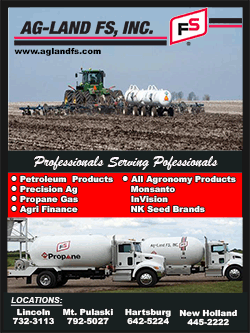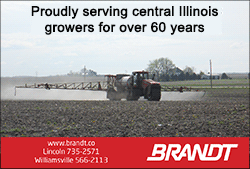|
 On September 4th, Secretary of Agriculture Sonny Perdue,
announced the Market Facilitation Program (MFP). This is to
assist farmers impacted by trade disruptions resulting from
retaliatory tariffs from foreign nations. On September 4th, Secretary of Agriculture Sonny Perdue,
announced the Market Facilitation Program (MFP). This is to
assist farmers impacted by trade disruptions resulting from
retaliatory tariffs from foreign nations.
Most Illinois producers remember the Loan Deficiency Payment
Program (LDP) from years back. The payment rate could change,
daily, so the market had to be monitored daily. LDP's were
complex and time consuming. MFP is much more simplified. You
have until January 15th, 2019 to sign up and May 1st, 2019 to
bring in your protection evidence. You can do this all before
January 15th in one trip if you so choose.
Have a safe harvest and visit your local USDA-Farm Service
Agency Office when you are done harvesting.
Thanks much,
William Graff
State Executive Director
Market Facilitation Program (MFP)
USDA launched the trade mitigation package aimed at assisting
farmers suffering from damage due to unjustified trade
retaliation by foreign nations. Producers of certain commodities
can now sign up for the Market Facilitation Program (MFP).

USDA’s Farm Service Agency (FSA) will administer MFP to provide
payments to corn, cotton, dairy, hog, sorghum, soybean, wheat,
shelled almond, and fresh sweet cherry producers. An
announcement about further payments will be made in the coming
months, if warranted.
The sign-up period for MFP runs through Jan. 15, 2019, with
information and instructions provided at
www.farmers.gov/mfp.
MFP provides payments to producers of eligible commodities who
have been significantly impacted by actions of foreign
governments resulting in the loss of traditional exports.
Eligible producers should apply after harvest is complete, as
payments will only be issued once production is reported.
A payment will be issued on 50 percent of the producer’s total
production, multiplied by the MFP rate for a specific commodity.
A second payment period, if warranted, will be determined by the
USDA.
For a list of initial MFP payments rates, view the MFP Fact
Sheet.
MFP payments are capped per person or legal entity as follows:
-
A combined $125,000 for eligible crop commodities
-
A combined $125,000 for dairy production and hogs
-
A combined $125,000 for fresh sweet cherries and almonds
Applicants must also have an average adjusted gross income for
tax years 2014, 2015, and 2016 of less than $900,000. Applicants
must also comply with the provisions of the Highly Erodible Land
and Wetland Conservation regulations.
Expanded Hog Timeline
USDA has expanded the timeline for producers with whom the
August 1, 2018, date does not accurately represent the number of
head of live hogs they own. Producers may now choose any date
between July 15 to August 15, 2018 that correctly reflects their
actual operation.
MFP applications are available online at
www.farmers.gov/mfp.
Applications can be completed at a local FSA office or submitted
electronically either by scanning, emailing, or faxing. To
locate or contact your local FSA office, visit
www.farmers.gov.

Direct Loans
FSA offers direct farm ownership and direct farm operating loans
to producers who want to establish, maintain or strengthen their
farm or ranch. FSA loan officers process, approve and service
direct loans.
Direct farm operating loans can be used to purchase livestock
and feed, farm equipment, fuel, farm chemicals, insurance and
other costs including family living expenses. Operating loans
can also be used to finance minor improvements or repairs to
buildings and to refinance some farm-related debts, excluding
real estate.
Direct farm ownership loans can be used to purchase farmland,
enlarge an existing farm, construct and repair buildings, and to
make farm improvements.
The maximum loan amount for both direct farm ownership and
operating loans is $300,000 and a down payment is not required.
Repayment terms vary depending on the type of loan, collateral
and the producer's ability to repay the loan. Operating loans
are normally repaid within seven years and farm ownership loans
are not to exceed 40 years.
Please contact your local FSA office for more information or to
apply for a direct farm ownership or operating loan.
Conduct USDA Business Online By Creating An eAuthentication
Account
The Internet allows you, the customer, access to USDA
information 24 hours a day, seven days a week. You can fill out
and submit electronic forms (eForms) any time of the day or
night from anywhere you have Internet access. This new service
delivery option allows you to complete and file your own forms
or applications online, because your signature is already
electronically "on file."
Information submitted to the Federal Government remains safe and
secure because every customer has a unique User ID and password;
only authorized USDA employees can access your information. It's
safe, saves paper, saves a visit to your local USDA Service
Center and provides electronic tracking of all your USDA
transactions.
How to Sign Up for eAuth:
Begin the process by reviewing the information at the USDA
Website
https://www.eauth.usda.gov. This website describes the
services available for Level 1 and Level 2 Accounts. Level 1 and
Level 2 accounts require that you have an email address so you
can register, create a customer profile, and be able to respond
to a confirmation email. Level 1 Accounts do not require you to
provide proof of your identity at a local USDA Service Center.
Level 1 Accounts provide limited access to certain USDA Web site
portals that require no authentication or authorization. A Level
2 Account does require a visit to a USDA Service Center with
proof of your identity. That is because a Level 2 account allows
you access to complete and submit documents and forms
electronically.

LEVEL 1 ACCOUNT
STEP 1. To obtain a Level 1 Account, you may
self-register online at www.eauth.egov.usda.gov.
Scroll down and click on the button that says “Sign Up for a
Level 1 Account.” Complete the brief customer profile.
STEP 2. You will receive a confirmation email, and you
must respond to it within 7 days to activate your account.
LEVEL 2 ACCOUNT
STEP 1. To obtain a Level 2 Account, you must complete an
18 question customer profile and prove your identity by
presenting state or federal photo ID at a local USDA Service
Center. Go to
www.eauth.egov.usda.gov, scroll down and click on
“Sign Up for a Level 2 Account.” Complete your customer profile,
which includes designating your user ID and password created by
you, contact information and email information. The data you
enter in your customer profile must match the data on the
document you use as identification at your local USDA Service
Center. Example: Your first and last names and address must
match the government-issued photo ID you plan to use to prove
your identity. Identify proof can only be verified by one of the
following documents: Current State Driver’s License, State Photo
ID, US Military ID, or United States Passport.
STEP 2. After completing your customer profile and
submitting it online, you will receive a confirmation email, and
you must respond to it within 7 days to activate your account.
STEP 3. Then you must complete the “Identify Proofing”
process by visiting a local USDA Service Center. You will be
required to present the eligible photo ID to an USDA employee
who will verify your identity and enter the expiration date of
the ID document used.
STEP 4. The USDA employee then will update your customer
profile to a Level 2 Account. You will have access to USDA
online applications and forms within one hour of your account
being updated.
You now have access to complete and submit documents and forms
electronically. USDA continues to update and make more forms and
programs available electronically.
Farm Reconstitutions
When changes in farm ownership or operation take place, a farm
reconstitution is necessary. The reconstitution — or recon — is
the process of combining or dividing farms or tracts of land
based on the farming operation.

To be effective for the current Fiscal Year (FY), farm
combinations and farm divisions must be requested by August 1 of
the FY for farms subject to the Agriculture Risk Coverage (ARC)
and Price Loss Coverage (PLC) program. A reconstitution is
considered to be requested when all:
-
of the required signatures are on FSA-155
-
other applicable documentation, such as proof of ownership,
is submitted.
Total Conservation Reserve Program (CRP) and non-ARC/PLC farms
may be reconstituted at any time.
The following are the different methods used when doing a farm
recon:
Estate Method — the division of bases, allotments and
quotas for a parent farm among heirs in settling an estate;
Designation of Landowner Method — may be used when (1)
part of a farm is sold or ownership is transferred; (2) an
entire farm is sold to two or more persons; (3) farm ownership
is transferred to two or more persons; (4) part of a tract is
sold or ownership is transferred; (5) a tract is sold to two or
more persons; or (6) tract ownership is transferred to two or
more persons. In order to use this method the land sold must
have been owned for at least three years, or a waiver granted,
and the buyer and seller must sign a Memorandum of
Understanding;
DCP Cropland Method — the division of bases in the same
proportion that the DCP cropland for each resulting tract
relates to the DCP cropland on the parent tract;
Default Method — the division of bases for a parent farm
with each tract maintaining the bases attributed to the tract
level when the reconstitution is initiated in the system.
2019 Acreage Reporting Dates in Illinois
December 15, 2018 - fall seeded small grains, canola, and
perennial forage
January 2, 2019 - honey
January 15, 2019 - apples, asparagus, blueberries,
caneberries, cherries, grapes, nectarines, peaches, pears,
plums, strawberries, other perennial crops
June 15, 2019 - cucumbers (planted 5/1-5/31)
July 15, 2019 - all other spring and summer planted crops
(corn, soybeans, pumpkins, sweet corn, etc.)
August 15, 2019 - cabbage (planted 6/1-7/20)
September 15, 2019 - cucumbers (planted 6/1-8/15)
The following exceptions apply to the above acreage reporting
dates:
If the crop has not been planted by the above acreage reporting
date, then the acreage must be reported no later than 15
calendar days after planting is completed.
If a producer acquires additional acreage after the above
acreage reporting date, then the acreage must be reported no
later than 30 calendars days after purchase or acquiring the
lease. Appropriate documentation must be provided to the county
office.
If a perennial forage crop is reported with the intended use of
“left standing,” or “seed,” then the acreage must be reported by
July 15th.
Noninsured Crop Disaster Assistance Program (NAP) policy holders
should note that the acreage reporting date for NAP covered
crops is the earlier of the applicable dates or 15 calendar days
before grazing or harvesting of the crop begins.
[to top of second column] |

In order to comply with FSA program eligibility requirements,
all producers are encouraged to visit their local FSA office to
file an accurate crop certification report by the applicable
deadline.
For questions regarding crop certification and crop loss
reports, please contact your local FSA office.
Farm Storage Facility Loans
FSA’s Farm Storage Facility Loan (FSFL) program provides
low-interest financing to producers to build or upgrade storage
facilities and to purchase portable (new or used) structures,
equipment, storage and handling trucks.
The low-interest funds can be used to build or upgrade permanent
facilities to store commodities. Eligible commodities include
corn, grain sorghum, rice, soybeans, oats, peanuts, wheat,
barley, minor oilseeds harvested as whole grain, pulse crops
(lentils, chickpeas and dry peas), hay, honey, renewable
biomass, fruits, nuts and vegetables for cold storage
facilities, floriculture, hops, maple sap, rye, milk, cheese,
butter, yogurt, meat and poultry (unprocessed), eggs, and
aquaculture (excluding systems that maintain live animals
through uptake and discharge of water). Qualified facilities
include grain bins, hay barns and cold storage facilities for
eligible commodities.
Loans up to $50,000 can be secured by a promissory note/security
agreement and loans between $50,000 and $100,000 may require
additional security. Loans exceeding $100,000 require additional
security.
Producers do not need to demonstrate the lack of commercial
credit availability to apply. The loans are designed to assist a
diverse range of farming operations, including small and
mid-sized businesses, new farmers, operations supplying local
food and farmers markets, non-traditional farm products, and
underserved producers.
To learn more about the FSA Farm Storage Facility Loan, visit
www.fsa.
usda.gov/pricesupport or contact your local FSA county
office. To find your local FSA county office, visit
http:// offices.usda.gov.

Preauthorized Debit Available for Farm Loan Borrowers
USDA Farm Service Agency (FSA) has implemented pre-authorized
debit (PAD) for Farm Loan Program (FLP) borrowers. PAD is a
voluntary and alternative method for making weekly, bi-weekly,
monthly, quarterly, semi-annual or annual payments on loans.
PAD payments are pre authorized transactions that allow the
National Financial and Accounting Operations Center (NFAOC) to
electronically collect loan payments from a customer’s account
at a financial institution.
PAD may be useful for borrowers who use nonfarm income from
regular wages or salary to make payments on loans or adjustment
offers or for payments from seasonal produce stands. PAD can
only be established for future payments.
To request PAD, customers, along with their financial
institution, must fill out form RD 3550-28. This form has no
expiration date, but a separate form RD 3550-28 must be
completed for each loan to which payments are to be applied. A
fillable form can be accessed on the USDA Rural Development (RD)
website at
http://www.rd.usda.gov/ publications/ regulations-guidelines.
Click forms and search for “Form 3550-28.”
If you have a “filter” on the account at your financial
institution, you will need to provide the financial institution
with the following information: Origination ID: 1220040804,
Agency Name: USDA RD DCFO.
PAD is offered by FSA at no cost. Check with your financial
institution to discuss any potential cost. Preauthorized debit
has no expiration date, but you can cancel at any time by
submitting a written request to your local FSA office. If a
preauthorized debit agreement receives three payment rejections
within a three month period, the preauthorized debt agreement
will be cancelled by FSA. The payment amount and due date of
your loan is not affected by a cancellation of preauthorized
debit. You are responsible to ensure your full payment is made
by the due date.
For more information about PAD, contact your local FSA office.
To find a local FSA office, visit
http://offices. usda.gov
Maintaining the Quality of Farm-Stored Loan Grain
Bins are ideally designed to hold a level volume of grain. When
bins are overfilled and grain is heaped up, airflow is hindered
and the chance of spoilage increases.
Producers who take out marketing assistance loans and use the
farm-stored grain as collateral should remember that they are
responsible for maintaining the quality of the grain through the
term of the loan.

Report Noninsured Crop Disaster Assistance Program (NAP)
Losses
The Noninsured Crop Disaster Assistance Program (NAP) provides
financial assistance to producers of non-insurable crops when
low yields, loss of inventory, or prevented planting occur due
to natural disasters including freeze, hail, excessive moisture,
excessive wind or hurricanes, flood, excessive heat and
qualifying drought (includes native grass for grazing), among
others.
Eligible producers must have purchased NAP coverage for 2018
crops. A notice of loss must be filed the earlier of 15 days of
the occurrence of the disaster or when losses become apparent,
or 15 days after the normal harvest date.
Producers of hand-harvested crops and certain perishable crops
must notify FSA within 72 hours of when a loss becomes apparent.
Eligible crops must be commercially produced agricultural
commodities for which crop insurance is not available, including
perennial grass forage and grazing crops, fruits, vegetables,
mushrooms, floriculture, ornamental nursery, aquaculture, turf
grass, ginseng, honey, syrup, bioenergy, and industrial crops.
For more information on NAP, contact your local FSA office or
visit www.
fsa.usda.gov/nap.
Marketing Assistance Available for 2018 Crops
The 2014 Farm Bill authorized 2014-2018 crop year Marketing
Assistance Loans (MALs) and Loan Deficiency Payments (LDPs).
MALs provide financing and marketing assistance for 2018 wheat,
as well as other commodities such as feed grains, soybeans and
other oilseeds, pulse crops, rice, wool and honey. MALs provide
producers interim financing after harvest to help them meet cash
flow needs without having to sell their commodities when market
prices are typically at harvest-time lows.
A producer who is eligible to obtain an MAL, but agrees to forgo
the loan, may obtain an LDP if such a payment is available.
To be eligible for an MAL or an LDP, producers must have a
beneficial interest in the commodity, in addition to other
requirements. A producer retains beneficial interest when
control of and title to the commodity is maintained. For an LDP,
the producer must retain beneficial interest in the commodity
from the time of planting through the date the producer filed
Form CCC-633EZ (page 1) in the FSA County Office. For more
information, producers should contact their local FSA county
office or view the LDP Fact Sheet.
Unauthorized Disposition of Grain
If loan grain has been disposed of through feeding, selling or
any other form of disposal without prior written authorization
from the county office staff, it is considered unauthorized
disposition. The financial penalties for unauthorized
dispositions are severe and a producer’s name will be placed on
a loan violation list for a two-year period. Always call before
you haul any grain under loan.

Application for Non-Insured Crop Disaster Assistance Program
(NAP) Payment Producers must file an application for payment on
form CCC-576 “Notice of Loss and Application for Payment”, Parts
D, E, F, and G, as applicable, to apply for payments within 60
days of the last day of coverage for the crop year for any NAP
covered crop in the unit. For annual crops, the coverage period
ends the earlier of the:
-
Date the crop harvest is complete
-
Normal harvest date for the crop
-
Date the crop is abandoned, or
-
Date the crop acreage is destroyed.
Eligible crops must be commercially produced agricultural
commodities for which crop insurance is not available, including
perennial grass forage and grazing crops, fruits, vegetables,
mushrooms, floriculture, ornamental nursery, aquaculture, turf
grass, ginseng, honey, syrup, bioenergy, and industrial crops.
For more information on NAP, contact your local FSA office or
visit www.fsa.usda.gov/nap.
Payments to Deceased Producers
In order to claim a Farm Service Agency (FSA) payment on behalf
of a deceased producer, all program conditions for the payment
must have been met before the applicable producer’s date of
death.
If a producer earned a FSA payment prior to becoming deceased,
the following is the order of precedence of the representatives
of the producer:
-
administrator or executor of the estate
-
the
surviving spouse
-
surviving sons and daughters, including adopted children
-
surviving father and mother
-
surviving brothers and sisters
-
heirs of the deceased person who would be entitled to payment
according to the State law
In order for FSA to release the payment, the legal
representative of the deceased producer must file a form
FSA-325, to claim the payment for themselves or an estate. The
county office will verify and determine that the application,
contract, loan agreement, or other similar form requesting
payment issuance, was signed by the applicable deadline for such
form, by the deceased or a person legally authorized to act on
their behalf at that time of application.
If the application, contract or loan agreement form was signed
by someone other than the participant who is deceased, FSA will
determine whether the person submitting the form has the legal
authority to submit the form to compel FSA to pay the deceased
participant.

Payments will be issued to the respective representative’s name
using the deceased program participant’s tax identification
number. Payments made to representatives are subject to offset
regulations for debts owed by the deceased.
FSA is not responsible for advising persons in obtaining legal
advice on how to obtain program benefits that may be due to a
participant who has died, disappeared or who has been declared
incompetent.
_small.png)
Illinois Farm Service Agency
3500
Wabash Ave.
Springfield, IL 62711
Phone: 217-241-6600 ext. 2
Fax: 855-800-1760
www.fsa.usda.gov/il
State
Executive Director:
William J. Graff
State
Committee:
James Reed-Chairperson
Melanie DeSutter-Member
George Obernagel III-Member
Troy Uphoff-Member
Executive
Officer:
Rick Graden
Administrative Officer:
Dan Puccetti
Division
Chiefs:
Doug Bailey
John Gehrke
Randy Tillman
To find contact information fro your local office go to www.fsa.usda.gov/il |